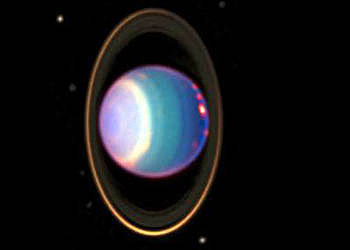Uranus' upper atmosphere and aurora
In this project, we study the upper atmosphere of ice giant planet Uranus and search for far-ultraviolet auroral emissions.

The rotational axis of the ice giant planet Uranus is almost parallel to the ecliptic plane and the magnetic field axis is tilted by 60° with respect to this rotational axis. This leads to seasonal (84-year orbit) and daily (17-hour rotation) variations in the Uranus system that are unlike at any other planet.
The observations of the bright hydrogen Lyman-α (H Lyα) emissions at Uranus by the Voyager spacecraft in 1986 enabled various findings: Efficient Lyα scattering by H2 in the upper atmosphere, a thermal atomic hydrogen exosphere and hot corona, and localized aurora near the magnetic poles. The Hubble Space Telescope (HST) observed Uranus between 1998 and 2017 at very different seasons than Voyager. In this project, this large set of HST spectra and images containing the prominent Lyα emission is analyzed for the first time.
Funding: SNSA 2020-00187
